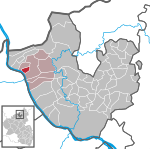The Battle of Remagen was an 18-day battle during the Allied invasion of Germany in World War II from 7 to 25 March 1945 when American forces unexpectedly captured the Ludendorff Bridge over the Rhine intact. They were able to hold it against German opposition and build additional temporary crossings. The presence of a bridgehead across the Rhine advanced by three weeks the Western Allies' planned crossing of the Rhine into the German interior.
After capturing the Siegfried Line, the 9th Armored Division of the U.S. First Army had advanced unexpectedly quickly towards the Rhine. They were very surprised to see one of the last bridges across the Rhine still standing.: 263–264 The Germans had wired the bridge with about 2,800 kilograms (6,200 lb) of demolition charges. When they tried to blow it up, only a portion of the explosives detonated. U.S. forces captured the bridge and rapidly expanded their first bridgehead across the Rhine, two weeks before Field Marshal Bernard Montgomery's meticulously planned Operation Plunder. The GIs' actions prevented the Germans from regrouping east of the Rhine and consolidating their positions.
The battle for control of the Ludendorff Bridge caused both the American and German forces to employ new weapons and tactics in combat for the first time. Over the next 10 days, after its capture on 7 March 1945 and until its failure on 17 March, the Germans used virtually every weapon at their disposal to try to destroy the bridge. This included infantry and armor, howitzers, mortars, floating mines, mined boats, a railroad gun, and the giant 600 mm Karl-Gerät super-heavy mortar. They also attacked the bridge using the newly developed Arado Ar 234B-2 turbojet bombers. To protect the bridge against aircraft, the Americans positioned the largest concentration of anti-aircraft weapons during World War II: 189 leading to "the greatest antiaircraft artillery battles in American history". The Americans counted 367 different German Luftwaffe aircraft attacking the bridge over the next 10 days. The Americans claimed to have shot down nearly 30 percent of the aircraft dispatched against them. The German air offensive failed.On 14 March, German Reich Chancellor Adolf Hitler ordered Schutzstaffel (SS) General Hans Kammler to fire V2 rockets to destroy the bridge. This marked the first time the missiles had been used against a tactical objective and the only time they were fired on a German target. The 11 missiles launched killed six Americans and a number of German citizens in nearby towns, but none landed closer than some 500 metres (1⁄4 mi) from the bridge. When the Germans sent a squad of seven navy demolition swimmers wearing Italian underwater-breathing apparatus, the Americans were ready. For the first time in combat, they had deployed the top-secret Canal Defence Lights: 410 which successfully detected the frogmen in the dark, who were all killed or captured.The sudden capture of a bridge across the Rhine was front-page news in American newspapers. The unexpected availability of a bridgehead on the eastern side of the Rhine more than two weeks in advance of Operation Plunder allowed Allied high commander Dwight Eisenhower to alter his plans to end the war. The Allies were able to rapidly transport five divisions across the Rhine into the Ruhr, Germany's industrial heartland. The bridge had endured months of aircraft bombing, direct artillery hits, near misses, and deliberate demolition attempts. It finally collapsed at 3:00 pm on 17 March, killing 33 American engineers and wounding 63. But by then U.S. Army combat engineers had finished building a tactical steel treadway bridge and a heavy duty pontoon bridge followed by a Bailey bridge across the Rhine. Over 125,000 troops established a bridgehead of six divisions, about 125,000 troops, with accompanying tanks, artillery pieces, and trucks, across the Rhine. The Americans broke out of the bridgehead on 25 March 1945, 18 days after the bridge was captured. Some German and American military authorities agreed that capturing the bridge shortened the war, although one German general disputed this. The Ludendorff Bridge was not rebuilt following World War II. In 2020, plans were initiated to build a replacement suspension bridge for pedestrians and cyclists. There is no other river crossing for 44 km (27 mi) and few ferries. Local communities indicated an interest to help fund the project and an engineer was commissioned to draw up plans.









